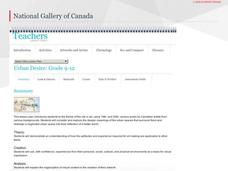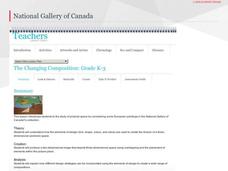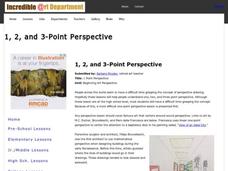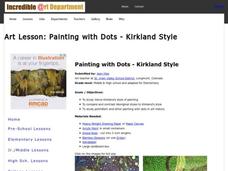National Gallery of Canada
Contemporary Reflections
Combine art and writing in a lesson about legends. After viewing Inuit art, class members examine their own cultural surroundings in order to write and visually represent a legend. Individuals are invited to take the creative reins when...
National Gallery of Canada
Build Me a Legend
Legends are full of imagery and action. Transfer a scene from a legend to a three-dimensional art piece. Class members first view Inuit art and discuss legends. They then build scenes that include action, setting, and characters.
National Gallery of Canada
Transformation
Create colorful cool or warm butterflies with simple materials. Class members draw their designs, spray the marker to diffuse the colors, and attach pipe cleaners to form the shape of a butterfly with antennae. Individuals must be able...
National Gallery of Canada
Urban Desire
Urban spaces are often overlooked and broken down. Offer your pupils the opportunity to reimagine an urban space. Learners examine and discuss works of art related to this theme and consider their own communities. Small groups then...
National Gallery of Canada
Urban Scenes
Select a theme together to guide and inspire works of art. Class members view images of art and discuss the images of cities. After choosing a theme, individuals create posters that reflect and contribute to the theme. They can use paint...
Curated OER
Now That's Beautiful!
Your class experiences dozens of messages about beauty every day by reading magazines, watching movies, and listening to the radio. Have them analyze society's view of beauty in groups after discussing several resources, including Dove's...
Curated OER
The View From Here
Study the beauty of the landscape around you with an innovative art lesson. After discussing the foreground, background, and middle ground of landscape art, kids work on making their own piece of landscape art. The lesson provides...
National Gallery of Canada
Me or You in the 30's?
Take on portrait painting and tertiary colors with a plan focused on recreating a photograph. After viewing several pieces of artwork, class members follow the instructions included here to create portraits or self-portraits in a...
National Gallery of Canada
Social Realism
Examine social strife in art. Class members first observe some pieces, and then find an image to inspire their own art. They outline the picture, analyze the composition, make alterations, and color their work.
National Gallery of Canada
Reading Symbols
Introduce your upper-elementary students to printmaking. Class members view prints, select and research symbols in a piece, and create their own sets of prints using styrofoam trays. Pupils can wash off the paint on their trays to make...
National Gallery of Canada
Home Sweet Home
What are your pupils' homes like? Incorporate their homes into a drawing lesson. Using an enlarged photograph, class members draw a grid so they can easily split their drawing in half. The final product should demonstrate cool colors,...
National Gallery of Canada
My First Print
Practice printmaking with a fun lesson. After observing images, class members use the listed materials, such as stamps and sponges, create their own prints. They experiment with layering, pressure, and paint colors.
National Gallery of Canada
Memories of the Past
Explore contemporary American Indian art. After viewing a set of images, class members discuss the design elements of techniques present, as well as how these artists represent history and culture. Learners examine the parfleche and...
National Gallery of Canada
Make a Parfleche
Examine American Indian art and culture by observing contemporary art and creating original pieces. Class members discuss artwork included in the plan and use these images to help inspire their own work, which should represent their...
National Gallery of Canada
Mastering One-Point Perspective
Cover one-point perspective through observation and practice. Class members examine several works of art that use one-point perspective, look at magazine images to find the vanishing points and horizon lines, and draw their own city...
National Gallery of Canada
The Changing Composition
Play with dimensions and practice making a two-dimensional scene look three-dimensional. Class members view pieces of art and then make their own scenes by layering different materials and drawing in details. Check out all the tabs for...
Incredible Art
Tints and Shades Hanging
Here's a mobile assignment that will brighten up your classroom. Each group is assigned one color from the color wheel, paints the pure color, three tints, and three shades of that color on precut forms the group designs, and hangs the...
Incredible Art
1, 2, and 3-Point Perspective
Introduce drawing high schoolers to perspective with a series of instructional activity that detail how to draft images in one-, two-, and three-point perspective. Each exercise includes step-by-step, illustrated directions and examples.
Incredible Art
Painting with Dots - Kirkland Style
Pointillism is the focus of a lesson that asks young artists to compare Vance Kirkland's painting style with aboriginal dot art, and then to produce their own piece of dot art.
Curated OER
Treble Clef Quiz Part I: The Basics
This three-part quiz tests learners knowledge of the treble clef by asking them to name the parts of the treble clef, to write the letter names under the notes represented, and to write the note names on the correct line or space.
Curated OER
Outline: Notes of the Treble Clef Staff
Score one for test prep. Young musicians are encouraged to create their own mnemonic devices to prepare themselves for a test on the treble clef staff. Using the provided worksheet, individuals record, in order, the names of the lines...
Curated OER
Outline: Notes of the Bass Clef Staff
Young musicians demonstrate their knowledge of the bass clef staff and prepare for an assessment by completing a fill-in-the-blanks worksheet
Curated OER
Bass Clef Note Names Test
Asses your musicians' knowledge of clef note names with a two-page test that asks them to identify the names represented by the nomenclature and then to place a whole note on the line or space that is appropriate for the letter name.
Curated OER
Rhythm Jam
Groups create, memorize, and perform for the class a 4 beats per measure rhythm pattern using percussion instruments including xylophones, rhythm sticks, and drums. The pattern is recorded on the worksheet provided in the resource.

























